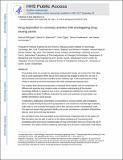Drug deposition in coronary arteries with overlapping drug-eluting stents
Author(s)
Olgac, Ufuk; Poulikakos, Dimos; Kurtcuoglu, Vartan; Rikhtegar Nezami, Farhad; Edelman, Elazer R
Downloadnihms805243.pdf (2.607Mb)
PUBLISHER_CC
Publisher with Creative Commons License
Creative Commons Attribution
Terms of use
Metadata
Show full item recordAbstract
Drug-eluting stents are accepted as mainstream endovascular therapy, yet concerns for their safety may be under-appreciated. While failure from restenosis has dropped to below 5%, the risk of stent thrombosis and associated mortality remain relatively high. Further optimization of drug release is required to minimize thrombosis risk while maintaining therapeutic dose. The complex three-dimensional geometry of deployed stents together with the combination of diffusive and advective drug transport render an intuitive understanding of the situation exceedingly difficult. In situations such as this, computational modeling has proven essential, helping define the limits of efficacy, determine the mode and mechanism of drug release, and identify alternatives to avoid toxicity. A particularly challenging conformation is encountered in coronary arteries with overlapping stents. To study hemodynamics and drug deposition in such vessels we combined high-resolution, multi-scale ex vivo computed tomography with a flow and mass transfer computational model. This approach ensures high geometric fidelity and precise, simultaneous calculation of blood flow velocity, shear stress and drug distribution. Our calculations show that drug uptake by the arterial tissue is dependent both on the patterns of flow disruption near the wall, as well as on the relative positioning of drug-eluting struts. Overlapping stent struts lead to localized peaks of drug concentration that may increase the risk of thrombosis. Such peaks could be avoided by anisotropic stent structure or asymmetric drug release designed to yield homogeneous drug distribution along the coronary artery and, at the least, suggest that these issues need to remain in the forefront of consideration in clinical practice.
Date issued
2016-07Department
Massachusetts Institute of Technology. Institute for Medical Engineering & ScienceJournal
Journal of Controlled Release
Publisher
Elsevier
Citation
Rikhtegar, Farhad et al. “Drug Deposition in Coronary Arteries with Overlapping Drug-Eluting Stents.” Journal of Controlled Release 238 (September 2016): 1–9 © 2016 Elsevier B.V.
Version: Final published version
ISSN
0168-3659